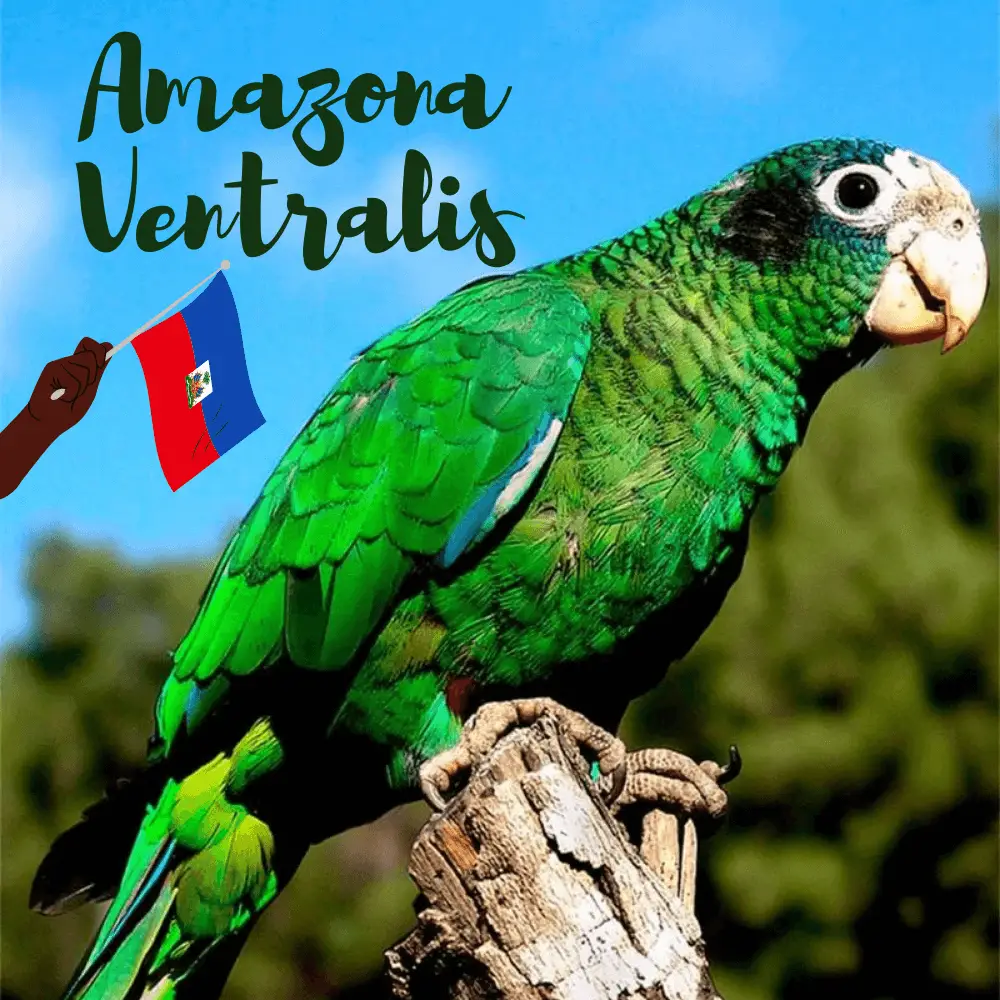
The Hispaniolan Amazon or Hispaniolan parrot or Amazona ventralis is a Parrot species of bird in the Psittacidae family. It is the most slender species of the genus Amazona.
Hispaniolan Amazon Parrot
SOURCE:MrJonnyharry
CARACTÉRISTIQUES
- TAILLE :28 – 32 cm
- POIDS :250 – 300 g
- LONGÉVITÉ :60 – 80 ans en captivité
- INCUBATION/PONTE :26 – 29 jours 2 – 4 œufs
- RÉGIME ALIMENTAIRE :Granivore et frugivore
Description
This species measures 28 cm. Its plumage is green with dark red markings on the belly. Its forehead is white up to eye level where this coloration blends with the white of the eye circles. The green coloration of the periocular areas has clear black reflections. The edge of the wings and remiges is blue. The beak is whitish with a poorly developed wax and the nostrils quite wide. The legs are pinkish gray.
28-31 cm. length and 250 grams.
The Hispaniola Amazon (Amazona ventralis) has the front Lords color and white (extension of the variable); the crown and upper cheeks with blue feathers and tips of black color; headphone ears Yes low cheeks, colored charcoal (variable measure); neck feathers and neck cà ́tés, emerald green with visible black tips.
Coat Yes back green grass with black tips, which gradually become less visible at the bottom; Grupa Green, slightly yellowish; yellow-green supracaudal tectrices. large blue blankets; remaining coberteras the green grass. Primary Yes secondary, azules, darker towards the tips, on the internal networks. Bajo las wings, Green; blue-green flight feathers.
The lower parts are usually of green color, slightly yellowish, con la mayoría de las Plumas mostrando márgenes negros bastante visible (especially in the upper region) but sometimes with some chin red feathers; a resizable brown piece in the center of the belly; covering pale yellow-green infracaudals. From above, the tail is green (perhaps a little darker than the rest of the upper parts) with a visible yellow tip and external feather networks with blue margins; at the bottom, the tail is yellowish, with the bases of the outer feathers red. Woodpecker Rose; brownish-white cere; white orbital ring skin; marrón el iris; pale gray legs.
There is no sexual dimorphism. Young as an adult, but less in the crown blue, and the abdominal piece is paler brown.
NOTE
Some authors consider the Amazon of Hispaniola (belonging to the same species) as the Amazon of Cuba. Although closely related, It is considered quite different due to the differences in pronounced plumage hue.
Hispaniolan amazon parrot

Food
They feed, among others, on seeds o fruits of Caesalpinia, Psidium Yes Ficus, seeds of wild oranges Citrus, corn Yes bananas.
Distribution
This species inhabits the island of Hispaniola (Haiti and Dominican Republic). A few years ago, Amazons from Hispaniola were illegally captured and transported to Puerto Rico for sale. However, the smugglers were arrested and the birds were released a few kilometers from the port of Mayagüez, thus introducing this species to the island. Currently, a large population lives in Puerto Rican palm groves and fields.
Habitat
The Hispaniola Amazon frequents the arid forests of the plateaus and the humid forests of the mountains.
This bird lives in various forest habitats: sandy savannahs of palm trees; arid plains; highland pine forests and humid mountain forests.
REGION OF ORIGIN
Dominican Republic, Haiti
Behavior
Birds belonging to this species move in groups, sometimes large, and feed in the fields. As a result, it is considered harmful by farmers.
Reproduction
Nests are usually built in tree cavities, but also in rock crevices, cactus voids, and cavities in coconut. Territorial and very aggressive while playing. The breeding season covers the months from February to May. Clutch 2-3 eggs.
USA breed from the end of March in tree cavities where the female lays 2-4 eggs that she incubates for 25 days. The young leave the nest around the age of 6 weeks and become independent 6-8 weeks later.
Related Articles:




















